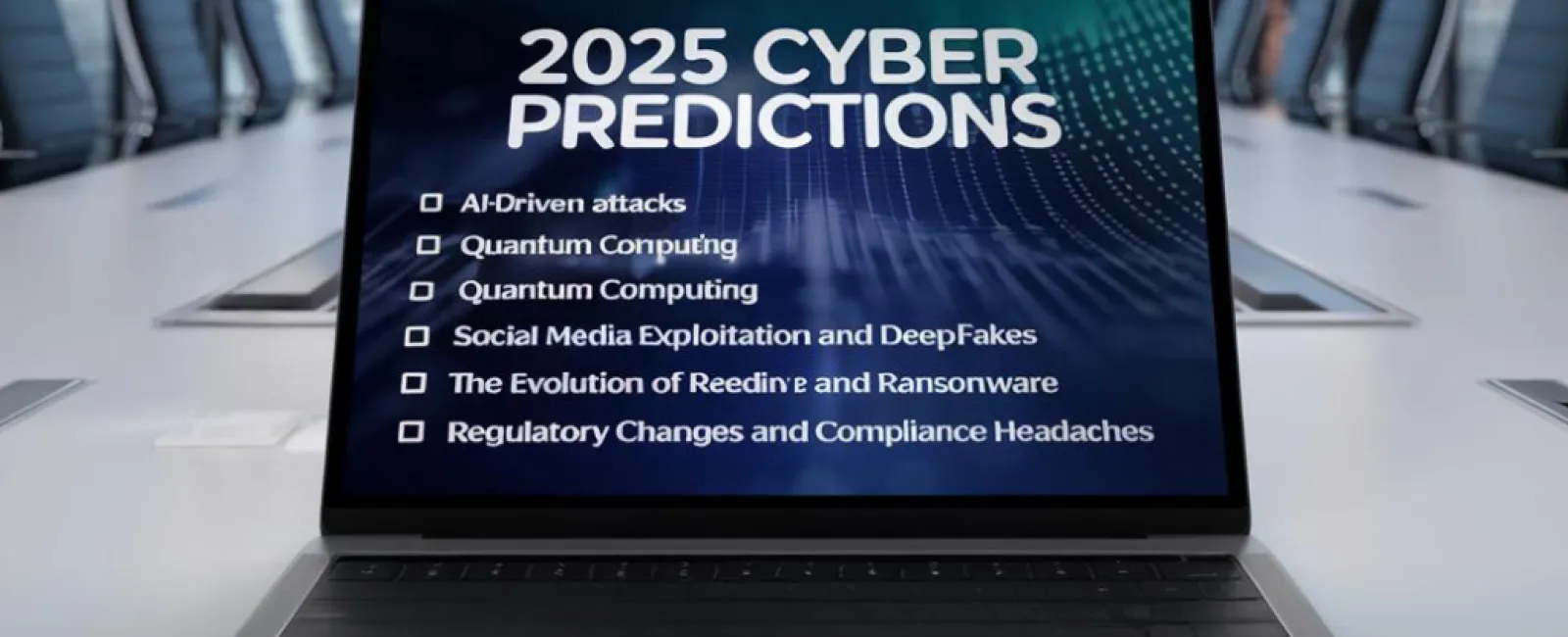December 09, 2024
Cyberthreats have progressed at such a rapid pace that scenarios once confined to science fiction have now become reality. From AI-driven cyber-attacks to the transformative potential of quantum computing, the cybersecurity landscape of 2025 promises to be both innovative and daunting. Here's an overview of some of the most significant threats on the horizon and steps small and medium-sized businesses can take now to prepare.
1. AI-Driven Attacks: More Intelligent, Swift, and Elusive
Artificial intelligence is a double-edged sword in the realm of cybersecurity. While it enhances sophisticated defenses, it also fuels cybercrime. In 2025, AI is expected to play a major role for hackers, enabling highly targeted phishing scams, creating malware that adapts in real-time, and automating attacks that outpace traditional security measures.
Preparation Tips: Invest in advanced detection tools that leverage machine learning to identify these intelligent attacks. Train your team to recognize AI-enhanced phishing emails that appear highly personalized and authentic. Staying ahead of AI requires a robust tech arsenal complemented by human vigilance.
2. Quantum Computing: A Potential Threat to Current Encryption
Quantum computing, once theoretical, is advancing rapidly and could potentially compromise many of today's encryption standards. Unlike traditional computers that process data in bits (ones and zeroes), quantum computers use qubits that can represent multiple states simultaneously, solving complex calculations much faster. While this isn't an immediate threat, by 2025, quantum advancements may begin to undermine current data protection methods, enabling hackers to crack even the strongest encryptions.
Preparation Tips: Begin researching quantum-resistant encryption now. Early adoption will position you better as quantum technology advances. Incorporate this into your long-term cybersecurity strategy to avoid last-minute scrambling.
3. Social Media Exploitation and Deepfakes: Misinformation Amplified
Social media is a powerful tool, both positively and negatively. By 2025, expect an increase in the use of social media for spreading misinformation and executing sophisticated social engineering attacks. Deepfakes, or realistic yet fake audio and video content, will be used to impersonate executives, customers, or other trusted individuals.
Preparation Tips: Foster a culture of verification within your organization. Encourage employees to be skeptical of unexpected requests, even those that appear legitimate. Training and awareness are key defenses, helping your team identify manipulated content and social media scams before falling victim.
4. Ransomware Evolution: Increasingly Personal
Ransomware attacks have evolved beyond simply encrypting data; they now also involve data leakage. By 2025, double extortion will be the norm: cybercriminals not only lock systems but also threaten to release sensitive information if ransoms aren't paid. New sectors, including critical infrastructure, healthcare, and supply chains, are being targeted, where breaches could have catastrophic consequences.
Preparation Tips: Enhance your incident-response planning and invest in backup solutions that enable quick recovery without paying ransoms. Regularly test your backups and keep them off-network when possible to prevent compromise. While ransomware may be unavoidable, being prepared can prevent it from crippling your business.
5. Regulatory Changes and Compliance Challenges: A Call to Action
As cyberthreats increase, governments worldwide are tightening data protection and cybersecurity regulations. By 2025, businesses will likely face stricter requirements for data handling, privacy, and incident response. Navigating these regulations will be challenging, particularly for businesses operating internationally, where compliance demands vary widely.
Preparation Tips: Stay informed about regulatory developments in your industry and region. Assign a team member or hire a consultant to monitor these changes and ensure compliance. Integrating compliance into your cybersecurity strategy not only helps avoid legal issues but also strengthens your overall security posture.
Conclusion: Preparing for the Future of Cybersecurity
Cyberthreats continue to evolve, becoming more advanced and sophisticated. The best way to prepare? Start now. Equip your business with AI-driven defenses, explore quantum-resistant encryption, train your team to detect deepfakes, strengthen your ransomware response plan, and keep your compliance efforts current.If these predictions have you rethinking your cybersecurity strategy, now's the time to act. Reach out for a FREE Discovery Call, and we'll help ensure your business is ready to face the future of cybersecurity head-on. Click here or call us at 833-863-2120 to schedule now!












